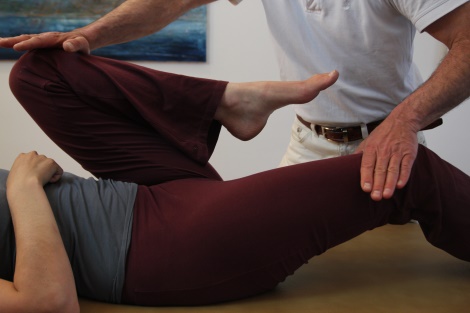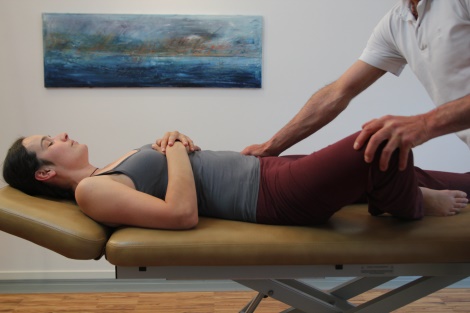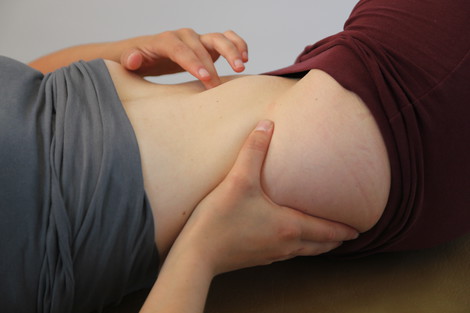Pelvic twisting in Integral Orthopedics
1 Overview
In the last decades we have learnt a lot about the connection of stress, trauma, the vagus nerve, our mind, emotions and body. Especially we have learned, that stress leads to a loss of the regulatory capacity of the autonomous nerve system with a weakening of the vagus nerve. This leads to loss of resilience and nearly all psychic and somatic problems and deseases.
As an orthopaedic and osteopathic doctor and practitioner of ortho-bionomy I have discovered some essential links in this field, that I like to share.
The Integral Orthopedics , as I called my method, shows:
1.dysstress is the main reason for low back pain, because it leads to a asymmetric hypertension of the fascial with torsion of the pelvis and the whole spine.
2.how you examine yourself or your patients to find out, if the body is in a stress mood with weakened regulation capacity.
3.what are the internal and external, acute or chronic sources of stress in our body.
4.how you can dissolve them.
5.how we can help our body to keep his regulatory capacity.
In the first decades of my work with acute and chronic pain patients, especially with low back pain, I found most of my patients having a pelvic twisting and a difficulty to keep the result of my work or that of other therapists.
Since discovering the navel integration in 2009 I worked with more than ten thousands of patients, published a book and gave many teachings. In the first years I found the method does not work always. Later I found the missing link in a disturbance of our external electromagnetic field, the so-called aura. Especially deeper emotional stress induces a disharmony in our aura, that inhibits our body, mind and emotions. And the relevance of this disturbance correlates with the size of our “stress cloud”. It’s origin can lay in our own older traumas or stress periods or those of others, who interfere with our energetic system. With the aura integration you also learn to feel your stress cloud and whatever it contains and to dissolve it whenever it reappears. With the stress test you can prove the interference of each source of stress in your body as well as in your aura with the pelvic twisting.
1.Pelvic twisting
Pelvic twisting means a twisting of the two halves of the pelvis against each other. It leads to a whole-body twisting with reduced resilience, chronic tension and weakness, especially in the lower back with a tendency to joint blockages, especially in the ISG and atlas area and the feet.
From the point of view of Integral Orthopedics, the cause is a stress-related regulatory disorder with a persistent state of stress or later exhaustion of the autonomic nervous system as well as the fascial system with consequences also for the function of all other organs, the immune system and the psyche. So the pelvic twisting can be seen as a sign of a blocked regulation capacity of the autonomous nerve system.
The cause of such a blocked regulation is always stress or trauma.
Internal causes of stress, such as physical and psychological trauma or the consequences of injuries, illness and operations, such as scars, can act as a source of interference or trauma field. Bad posture, weak muscles, shortened or thickened tendons or irritated articulations, specially in the upper and lower spine can reduce our resilience to other internal and external stress factors.
With the Integral Stress Test, internal and external causes of stress can be identified and with the integration techniques, these can be relaxed and integrated into the body’s own vibrational pattern. The simultaneous emotional release usually is very slight, but together with the regaining of the selfregulation capacity of the autonomous system it opens a door to a significant change in the process of knowing and handling oneself and in any kind of a therapy.
2.Anatomy and physiology
a The autonomic nervous system
The autonomous nervous system controls our unconscious body processes including our fascial system and connects body and psyche.
It reacts to excessive stress with a regulatory disorder, initially with a sustained stress mode and later with a sustained exhaustion mode.
The center of our inner regulation is the solar plexus of the sympathetic nerve centers, approximately at the level of the navel in front of the spine. Here all the informations from the fascial system and the vagus nerve are balanced in order to regulate all our inner organs, including our belly and heart brain. The solar plexus also regulates our emotions by opening or closing our limbic system with the Amygdalla.
During stress, it causes the release of stress hormones in the adrenal gland and an asymmetrical tension of the two muscle-fascia chains originating at the level of the adrenal glands and the solar plexus, which manifests itself as pelvic twisting.
b The fascial system
The fascial system wraps and connects all our muscles, internal organs vessels and nerves like a dense, three-dimensional spider web. It enables the dynamic stability of our musculoskeletal system and our internal organs
but also enables our unconscious, emotional body perception and communication. It can store emotions and it forms the way our body reacts on emotions.
c The electromagnetic field of the body or aura
The fascial system fulfills the anatomical base to be a crystal antenna. It works like a receiving and sending antenna and it produces an electromagnetic field which interferences with the electromagnetic body field and that of our surrending. Stress and Trauma can overload our Aura in a way that unsolved emotions and stress energy is kept in the Aura. This can be acute stress but also old traumatas. The overloaded aura inhibites the normal function of our fascial and autonomous nerve system including the stress test, described later. So if the stress test is negativ, this in most cases is a sign for an inhibiting aura. After releasing the aura by the later described techniques, always the pelvic twisting dissolves for a while and after it comes back the stress test functions normal.
d Interference foci
In a healthy state, all our cells vibrate in a harmonious, individual vibration pattern.
Overloaded or traumatically altered cell systems can irritate the entire system through a dysharmonic oscillation pattern as a so-called trouble spot.
Psychic overload or trauma can be stored as a disturbance field in our fascial system or our external oscillation fiel, our aura, and burden us and our life as a disturbance or trauma field.
An impaired resilience decompensates with additional stress. We notice this by corresponding tensions and pains and often also an increased irritability, lack of joy of life and creativity as well as quick exhaustion.
e The importance of the navel
In the navel all fascial strands and sheaths connect. According to modern trauma science, like somatic experience, an overload of traumatic emotions enters the body in the belly region and when it’s too much for being integrated it get’s stored in the body, inhibiting the regulation capacity. According to modern fascial science our unconscious perception and communication is based in the fascial system, which has its center in the belly bottom.
From the navel region, according to traditional Chinese medicine, the energy, or Qi is directed into the meridian circulation.
The navel integration demonstrably relieves the entire fascial and autonomic nervous system by relaxing the navel. And it leads the energy set free to regions with lack of energy like the throat or kidneys or traumatized regions. This helps often to free as well blocked emotions and
harmonizes the individual vibration of the whole body.
f The examination of the pelvic twisting
The pelvic twisting shows a shortened hip flexor mostly on the left and a restricted hip abduction mostly on the right.
Hip flexors (iliopsoas): while lying down, pull or push one after another your knees up to the chest as far as possible (!). The typical examination shows a lifting of the stretched leg on the side of the shortened hip flexor (usually on the left, on the photo on the right) when the mutual knee is pulled towards the chest.

Hip abductors (adductors):
On the side of the shortened adductors (usually on the right), the abduction of the flexed hip is reduced.

3 Stress as a cause
External stress due to bad posture, overload, lack of exercise, etc.
Psychological stress, especially if we have a similarly vibrating interference field due to corresponding overload in the past.
Inner stress through old trauma or overload consequences, e.g. in the form of disturbing scars
unresolved, fascially stored emotions
frequently or permanently blocked key joints, e.g. of the head joints, the jaw or the ankles
Overload of eyes, ears, immune system, especially of the tonsil region, allergies, chronic diseases, maloccupation of the intestine, malnutrition
4 Effects of stress and pelvic torsion
The autonomic nervous system loses its ability to regulate and remains mostly in tension or defense mode (sympathetic tone).
The corkscrew-like twisting of the spine, often with functional leg length discrepancy can have effects on all organs and regions supplied from the spine.
Orthopedic symptoms can range from headaches and neck pain with dizziness, visual disturbances, tinnitus, shoulder and arm pain, cardiac arrhythmias, chest tightness, upper or lower abdominal discomfort, to acute and chronic back, pelvic and leg pain.
The typical start-up pain in the back in the morning or after prolonged sitting often disappears with improved blood circulation to the cramped muscles through movement and heat. Strain pain usually increases with poor posture, especially prolonged sitting or standing, and frequent bending and heavy lifting.
Children often have less orthopedic than mental complaints and develop back pain and headaches only after puberty.
5 The Integral Stress Test
When touching the navel or an active source of disturbance, the pelvic torsion is directly released.
If this is not the case, there is always a disturbance in the aura in form of energetic interference field at the navel, the throat or in traumatized regions. The relief of which leads directly to pelvic relaxation.
The most common disturbance after stress is in the throat area. But many people have several disturbing zones in there body or an overloaded aura as well. Each of these has to be treated usually one or two minutes with the integration techniques. After each treatment the pelvis relaxes but the twisting reappears until all the stress or trauma areas have been relaxed and integrated in the system. It is essentially to treat them all, because if only one area remains, it will reactivate the others and disturbe the whole system. Usually most areas stay relaxed after one or two treatments. But the throat area and often the aura have to be treated daily or in times of stress several times a day.
In the case of advanced exhaustion without pelvic torsion, there is a fixed parasympathetic tone. The treatment involves the suspected interference fields until pelvic torsion first reappears and later disappears.
Earrings and piercings :
Sometimes also metal on or in the body can disturb. Take off earrings and always an umbilical piercing ! and check the pelvis.
Dental splints: It is best to test your bite splint first at the beginning and then again at the end of your self-treatment with regard to the pelvis.
6 Treatment with Fascia Integration Therapy (FIT)
6.1 Navel integration
The task of the navel hand:
One hand lies relaxed on the belly and, with the middle finger in the navel, pushes the navel very gently, just a very little, in the direction with the least resistance, which is also the most comfortable and produces a deep breath.
The task of the second hand:
a Front neck grip

Flank grip
The palm rests on the back of the deep lumbar muscle (quadratus lumborum) and the large dorsal fascia, as well as the kidneys and adrenal glands between the ribs and pelvis, especially if the kidney region feels cold and is sensitive to cold.

c Scar integration
Disturbing scars are touched very gently with the fingertips in the pleasant direction. Deep scars, such as after tonsillectomy or perineal tear or in the peritoneum after appendectomy or cesarean section, can also be cleared in this way by prolonged application of the second hand with shifting of attention into the depths.
Relieving a scar also releases energy that you can direct to an area of pain with your other hand. The treatment is particularly effective when you determine which pain zone is relaxed by unclogging which scar and then repeatedly connect it to the scar for relief as needed.
d pain zone integration:
The second hand is placed on a region of tension or pain.
6.2. Auraintegration
Self-treatment: both arms are hold in a wide circle in front of the stress area, mostly the throat and heart area or the belly area, in the beginning also scars or other traumatized zones. It’s essential to keep directly outside the border, where you feel the tension or discomfort until the tension subsides. You can imagine holding a stresscloud between your arms, that slowly disappears through the opening between your hands. Often you feel which stress you have stored, when it comes out. In the first treatments old traumas like the operation stress or psychic traumas come out and later it’s the daily stress that blocks the system and can be integrated thus.

Partner treatment: Depending on the traumatization, the distance that is still perceived as unpleasant can sometimes
be many meters. In our seminars each time , we have one or two pupils, who have to be treated from a distance of about 17 meters, the largest in our working place.
Summary
Pelvic twisting can be seen as a sign of decompensation of our regulatory systems. Our autonomous nerve system holds the sympathetic mode. The vagusnerve is inhibited. We cannot really relax and regenerate. The function of all our organs is inhibited. In our emotions dominates fear and our mind is restricted to a survival mood. I also see the pelvic twisting as the origin of most cases of low back pain.
With the Integral stress test we can find our internal or external stress sources and with the integration tecnifiques we can solve them ourselve or for our patients in few minutes. Once the old sources of stress are released, it’s enough to repeat the basic tecniques every day especially after stress and before sleeping. The examination of the pelvis with the Integral stress test shows us, where our limits are and when we need to repeat the exercises together with relaxing behaviour, such as Yoga or Sports.

Schreibe einen Kommentar